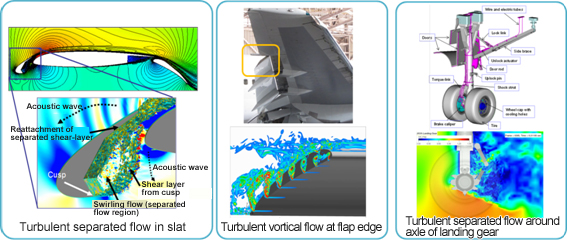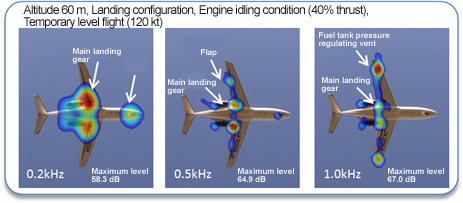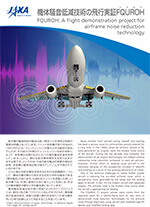Research & Development
JAXA promotes three research and development programs and a fundamental research program that underpins them.
Airframe noise reduction technology
JAXA has been studying airframe noise reduction technologies, a large fraction of which comes from high-lift devices (flap and slat) and landing gears. With the FQUROH project (FY2013-FY2018), JAXA has successfully demonstrated noise reduction concepts and design methodologies in a series of flight demonstration tests in 2016 and 2017.
Our ongoing challenge is to develop and verify the best optimized designs for high-lift devices and landing gear for passenger aircraft application based on our design methodology established to date.
Airframe Noise Reduction Technology FQUROH(7:17)
Background
Noise from aircraft during take-off and landing is a serious issue for communities around airports. The International Civil Aviation Organization (ICAO) set stricter standards on noise around airports. The standards are expected to become even more stringent in the near future. Airports limit the available time for takeoff and landing of noisy aircraft, and take-off and landing fees are charged depending on the aircraft noise level. With air traffic volume expected to grow to approximately 2.6 its current volume over the next 20 years, increasing demand for quieter aircraft that reduce current noise level is expected. Early-generation jet engines were major noise sources of aircraft because they generate larger noise while increasing output power for takeoff and landing. However, the development of low noise technologies of jet engines has helped achieve substantial noise reduction compared to these early jet engines. Recent aircraft with low-noise jet engines have markedly lowered overall airport noise levels. To reduce aircraft noise levels further, special attention must be devoted to aerodynamic noise by airframes (airframe noise), which begins to exceed engine noise as the pilot closes the engine throttle during approach procedures.
FQUROH (Flight demonstration of QUiet technology to Reduce nOise from High-lift configurations) project (FY2013-FY2018)
The FQUROH (Flight demonstration of QUiet technology to Reduce nOise from High-lift configurations) project is intended to reduce airframe noise, a large fraction of which comes from high-lift devices (flap and slat) and landing gears, and to verify the feasibility of practical application of airframe noise reduction technologies.
Please find news and releases on the results of a series of flight demonstrations in the FQUROH project.
Our approach
JAXA has been working on airframe noise reduction technology in cooperation with Japanese aircraft industries and universities, and NASA. Its research activities extend from basic studies to practical technology development: fundamental technologies to study airframe noise such as computational fluid dynamics (CFD), computational aeroacoustics (CAA), and experimental methods using wind tunnels; study on physical understanding of noise generation from high-lift devices and landings; and noise reduction technologies which will be applicable to actual aircraft.

Flaps are devices used to generate sufficient lift during slow flight (takeoff and landing). They extend from the trailing edge of the main wing. A slat is a similar device deployed from the leading edge. Although they generate higher lift without stalling, highly disturbed turbulent flow around them generates aerodynamic noise.
When flaps are deployed, strong vortexes are known to develop at the flap edge. Their turbulent flow causes aerodynamic noise at the flap edge. Practical flap-edge configuration devices that are applicable to actual aircraft have been studied. Their noise reduction effect has been confirmed in wind tunnel tests.
Slat noise is generated from swirling shear flow inside the slat cove (the concave part of slat). The turbulent shear flow produces noise as it passes through the gap between the slat and the leading edge of the main wing. Although noise can be reduced substantially by eliminating the shear flow with a modified smooth profile of a slat, storing of the slat presents a mechanical problem that is difficult to solve. Consequently, JAXA is studying concepts to serrate the lower part of the slat (cusp) to break down the large scale vortices in the shear layer which generate much of the noise.
Regarding the landing gear, noise is generated by highly vortical flow generated around very complicated geometries such as wheels, brakes, shock-absorbing structures, and hydraulic piping. Although covering such structures with a streamlined fairing can reduce noise effectively, it causes problems in cooling break system. To solve that problem, JAXA is developing a practical approach using a perforated fairing, which permit airflow to cool the brake system while reducing noise.
Flyover noise source measurement
Although it is possible to simulate noise generation physics and the effects of noise reduction technologies using wind tunnel experiments and numerical analysis, these tests and analyses are performed using aircraft parts only. Therefore, to confirm the validity of these tests and analysis results, accurate measurements of actual noise generated by aircraft in flight tests are important. JAXA has been developing a technology using a phased array microphone system. The measurement system, set on the ground for fly-over tests, can capture and localize the noise sources of flying aircraft. This noise source measurement will be a key technology to verify the effectiveness of noise reduction technologies that are being developed. JAXA is currently improving measurement systems and data processing to obtain higher accuracy and resolution in the measurements.

January 21, 2021
